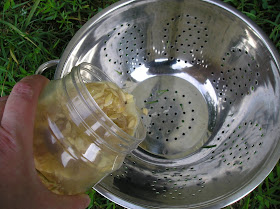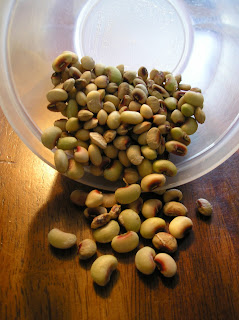These are the cucumbers we let go to seed. This is also a great book - The Seed-Starter's Handbook by Nancy Bubel. It is another of my old books with a copyright of 1978.
There are two options for drying cucumber seeds. One is to take out the pulp and wash off the seeds as best you can.
Frank is being the funny photographer while I am trying to figure out what to do. He has always been able to make me laugh. That is a wonderful attribute after 30+ years.
The other option is to scoop out the pulp and let it ferment for a few days.
So we did.


We left the jar sitting on the shelf for a few days and watched the pulp liquify like described in the book. But then it got to smelling so bad it had to migrate to the porch.


I used a colander and the garden hose to rinse out the pulp and fragrant liquid.

The lighter or less viable seeds floated to the top (just like the book described) and I was able to pour them off.

I poured the seeds onto a few layers of paper towels to absorb most of the moisture before spreading them out on a cookie sheet to dry.
We have also saved some purple hull pea seeds along the way. We let them mature, shell them and put them in this bowl to dry. I shake them around a few times each day as I walk by.
 We didn't save any corn seed this year because we planted two varieties together which would cross pollinate, making the seed not reliable for replanting. We wanted to use up the last of our oldest seed, but it wasn't enough, so we added another kind to the patch.
We didn't save any corn seed this year because we planted two varieties together which would cross pollinate, making the seed not reliable for replanting. We wanted to use up the last of our oldest seed, but it wasn't enough, so we added another kind to the patch. We went flower seed picking a few days ago. We had many, many zinnia volunteers come up this year in the garden which was wonderful. The hummingbirds love them and they help deter destructive insect pests. We have also planted more zinnias and marigolds this year throughout the garden. I hope we have many more volunteers next year. But to supplement them we are harvesting some seeds along the way.
Another first this year is sunflowers. You know those beautiful pictures you see of sunflowers lining someone's garden fence? I have always wanted to try growing them, but have never taken the time. Well, this year I poked a few seeds in the ground here and there in the garden, and you know what? They grew! And they are beautiful! Then one day I walked by and looked at some of them and they were dead. I wondered what was wrong until I tilted
the flower head up and saw sunflower seeds. Well, that is what they are supposed to do, right? That was a very fun discovery. So now I have 3 seed heads drying. Life is so great and rewarding!
We plan to save more seeds this summer, so we will keep you posted. We do this because there might come a day when we can't get any more seeds. What are you saving this year?
Until next time - Fern




.JPG)







Seed to Seed by Ashworth is excellent for seed saving. You should also try things like carrots and cabbage since they have a second season seed production.
ReplyDeleteThank you for the information. We plan to have carrots and cabbage in our fall garden.
DeleteFern
Thanks for sharing this; very interesting. We are just starting to read about seed saving and your article was very informative and helpful. Thank you.
ReplyDeleteYou are very welcome. Best of luck!
DeleteFern
Thanks for sharing you seed saving experiences at the HomeAcre Hop!
ReplyDeleteHope you join us again Thursday!
http://www.mittenstatesheepandwool.com